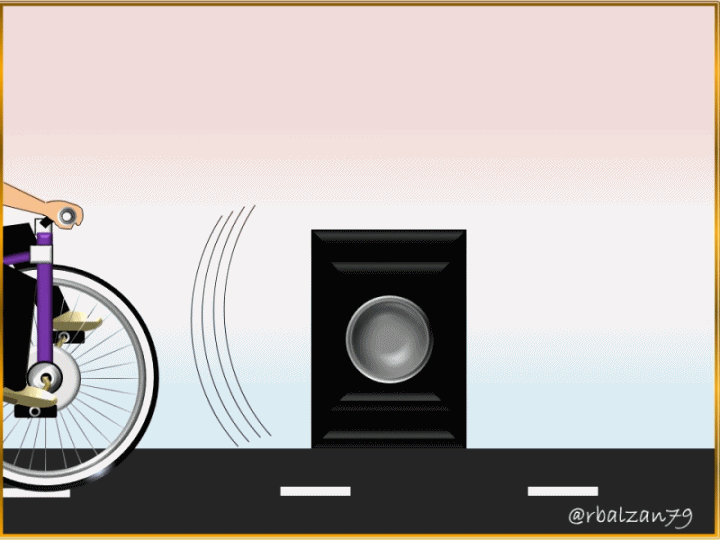Calculation of sound frequency in the Doppler effect (Receiver in motion)

Within the sound there are other phenomena, one of them, we have already started to analyze in previous publications as the Doppler effect, but on that occasion we did it with the condition where the sound receiver was motionless, now we will do it when the receiver is the one in motion and the source of sound emission motionless, that is, reversing the conditions of mobility, and for this, we will use the general formulation of the Doppler effect and adapt it to the conditions described above.
Here I share with you the previous publication of the Doppler effect.
Therefore, let us now describe the following practical exercise.
Exercise
A person riding an old bicycle approaches a source or source of sound emission, this person travels with a speed of 5 km/h, logically the sound that his ears perceive is propagated through the air, and whose speed of propagation through this medium is 340 m/s, and the frequency of emission of these sound waves is 1,250 Hz, therefore, in relation to all the above, answer the following questions:
a.- How can we analyze the general formulation of this phenomenon (Doppler Effect), when the receiver of the sound is the one being mobilized?
b.- What will be the frequencies perceived by the receiver moving towards the source of the sound emission, either approaching or moving away from the emitting source?
Solution
a.-In a previous installment we related to this phenomenon of the Doppler effect, in that occasion the sound receiver remained motionless, while the sound emission source was the one that moved or was in motion, now we will reverse these conditions, i.e., the receiver will be the one that moves, for this, we will begin by analyzing the general formulation for this phenomenon, and adapt it to the conditions given for this exercise.

fr = It is the frequency of the sound perceived by the receiver.
fo = Represents the sound frequency of the emitting source.
Vm = Velocity of the sound propagation medium (air in this case)
VR = Receiver speed.
Vf = Speed of the sound emitting source.
It is important to note that, if the sound emitting focus is immobile, its velocity will be zero, and thus we can go on to answer the second question, so formula 1 is reduced to the following:

With this formula 2, we can give an answer to the approach made, since we have adapted it to the conditions described in the exercise (receiver in motion and emitter focus immobile), therefore, we continue with the development.
b.- Data:
fo = 1250 Hz.
Vm = 340 m/s.
VR = 5 km/h * 1 h/3600 s * 1000 m/km = 1,39 m/s.
Before applying formula 2, it is important to note that we will use the plus sign (+) when the receiver of the sound approaches the source emitting these sound waves, and the minus sign (-) when it moves away, therefore, we can proceed with the following formula for the plus sign (+).


This is the frequency of the sound perceived by the receiver when it approaches the source of the sound emission.
Now let's see what happens when the receiver starts to distance itself from the source of the sound emission, for this, we present the following formulation for the minus sign (-):


This is the frequency of the sound perceived by the receiver when it moves away from the source of the sound waves.
Analysis of results
We continue to verify that the phenomenon that makes a receiver perceive different frequency to that emitted by a sound emitting source, is the Doppler effect, for this particular example, the frequency emitted by the sound emitting source was 1,250 Hz, and the calculated frequencies perceived by the receiver were 1. 255 Hz at the moment of approaching the sound emission source, and of 1,244.9 Hz at the moment of moving away, taking the given conditions, that is to say, the receiver in movement and, the sound emission source motionless or at rest, noticing with it, the following frequency relations of the sound.

Until another opportunity my dear friends.
Note: The images were created by the author using Power Point and Paint, the animated gif was structured with the PhotoScape application.
Recommended Bibliographic References
[1] MOVIMIENTO ONDULATORIO. Link.
[2] Doppler Effect. Link.
All this ae a new concept to me, but its good to learn on a daily basis. I will have to read more about this concept, thanks for providing hepful links
Hi dear friend @rbalzan79
I had already seen something of the Dopler effect in a chapter of the series The Big Bang Theory, but thanks to your post I am much clearer about scientific concepts
god bless you